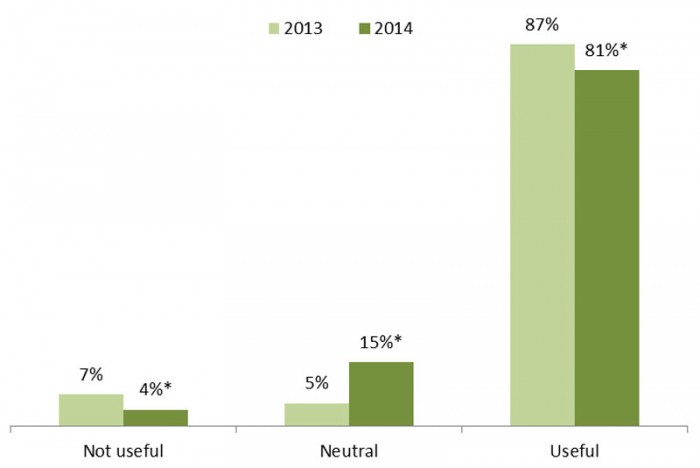Wouldn’t you feel better about a professional relationship when you feel that you:
- Have your thoughts and feelings validated?
- Get instant gratification?
- Have some control?
Patient Portals provide this and more!
According to ONC, patients enjoy going into patient portals provided to view their lab results and electronic health records. Almost 80% of patients in the study found access to their health data helpful.
Source: ONC
Geisinger Health’s study showed that patients with access to doctors’ notes were more aware of their treatment plans. This led to more engagement and more adherence to the prescribed medications.
Still other studies confirm that enabling patients to see notes from their doctors improved overall care.
Portal Benefits to Physicians

While many physicians have implemented portals under protest, kicking and screaming, the thing is, once training and implementation has occurred, the office is actually more productive. Patients and physicians are happier.
There are many benefits to implementing patient portals, such as:
- Providing new insurance information
- Processing payments
- Coordinating appointment scheduling without taking out staff time
- Updating patient demographics
- Exchanging messages
- Reviewing treatment plans or discharge instructions
- Reminding patients about appointments (and what to bring)
- Documenting patient conditions
- Obtaining medical and social histories
- Reminding patients to get their vaccinations, mammograms and other screening tests as they come due
Many physicians are surprised by the amount of time the office saves while providing better patient care.
For more information about this, check out the blog post:
How do physicians really feel about patient portal use?
Doctors are not fond of portal use because they are coerced to implement them to satisfy meaningful use requirements. Rather, doctors like them because it helps to encourage patient loyalty and to build a relationship with their patients
Zach Wood, director and general manager of member engagement at Cerner points out:
“Providers are trying to have relationships with these individuals and be able to effectively communicate with that population. Having bi-directional messaging between the patient and provider, not only is convenient on both sides, but it saves an administrative burden as well and being able to show that health record to the patient enhances the communication lines and provides self-service which is great for the patient and the provider.”
Portals also bolster patient compliance. They assist health professionals in educating their patients and preparing them for future care. When patients have access to their health data, they are better informed. This helps generate deep and meaningful conversations during doctor’s encounters.
So, Why aren’t Portals Used Effectively?
HealthMine’s survey reveals that despite the high portal adoption rate, only 20 % of patients use their portals to engage in shared decision-making with their providers. This is confirmed by other research . One Massachusetts-based research team showed that patients rarely use this to initiate care-related conversations with their providers despite appreciation for health data access.
How do providers promote patient portal use?
Clearly, portals won’t be if patients do not use them. While adoption is increasing, there is still room for growth.
According to Wood, explaining the benefits of the portal and encouraging usage should be done by every doctor and health professional during each office and hospital visit.
Wood says:
“You need a starting point with that relationship, but once you’ve started using it in some of the ways we’ve talked about, you definitely have more engaged populations.”
Studies confirm this, revealing positive provider testimony works extremely well in promoting patient portal adoption. Age discrimination sometimes mistakenly plays a part. According to Clain, too many providers assume that just because their patients are older, they may not want to use the portal. Clain’s research shows that is not the case.
Patients reaching their 60s are just as likely to use their portal, potentially due to their familiarity with the technology. Because of this, it is likely that portal adoption amongst older patients will continue to grow. Clain points out:
“If you look at patients in their 60s and up to 65, a lot of those patients are still in the workforce. They’ve had iPhones for 10 years since they were in their mid-50s.” “So I think that a lot of those patients are comfortable with using technology, and a patient portal may be a new approach to working with their physicians in a way that they didn’t do before, but they’re comfortable getting online, they’re comfortable using their phones to get on a portal, or using a computer.”
Another way to look at this is the number of consumers in the baby boomers and generation and senior sector are using Facebook. The over 65 year-old set has been the fastest growing segment using Facebook and other social media channels. Going forward, providers will need to maintain a pulse on the patient portal market.
While it’s clear that patient portals offer users a window into their own health by making EHR data more accessible, it is important to note the role they can play in boosting patient engagement and patient satisfaction.



